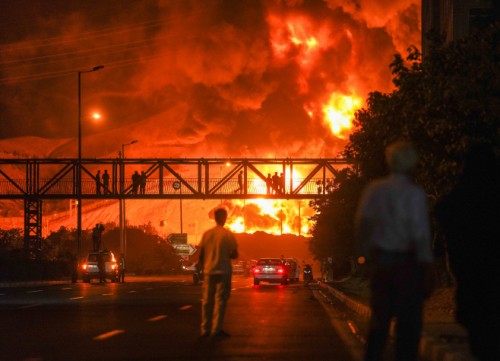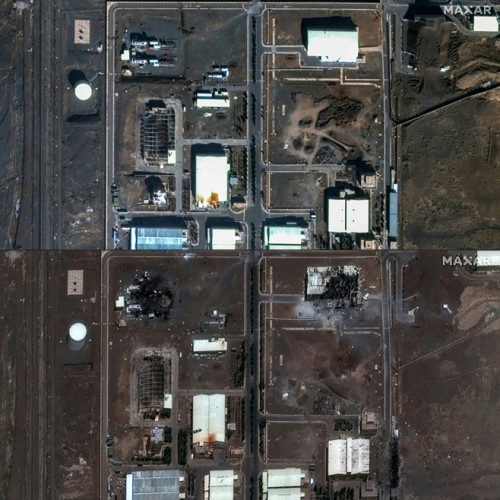 |
| Smoke rises from a refinery in Tehran, Iran, after an Israeli airstrike on the evening of June 15. / UPI-Yonhap |
Iranian state broadcaster IRIB was forced to cut its live programming on June 16 after an Israeli airstrike hit its headquarters, in what observers see as a symbolic indicator that Israel has seized air superiority over Iran.
Just an hour after warning residents of northern Tehran to evacuate, Israeli forces launched precision strikes on IRIB’s headquarters in Tehran’s District 3. A viral video showed a female anchor dressed in a chador live on air denouncing Israel when a sudden explosion rocked the studio. Thick gray smoke filled the room, parts of the ceiling collapsed, and staff could be heard shouting “Allahu Akbar” before the broadcast abruptly cut off.
 |
| A female Iranian anchor in a chador reacts as an explosion occurs during a live broadcast at the IRIB studio in Tehran on June 16. / AP-Yonhap News |
Iranian media reported that the main IRIB compound was hit twice around 6:30 p.m. local time, causing a massive fire. AP reported the building was struck by four bombs. The broadcaster later resumed with pre-recorded content, and the same anchor reappeared from a different studio, stating that some journalists had died in the blast.
Israeli Defense Minister Israel Katz said the IRIB building was a legitimate military target, describing it as a propaganda arm of the Iranian regime. “We will strike the Iranian dictators wherever they are,” he declared.
Before the strike, the Israel Defense Forces (IDF) had issued a Persian-language warning via X (formerly Twitter), stating it would carry out operations against military facilities in District 3. The area is home to IRIB, police headquarters, three major hospitals, and houses about 330,000 residents, according to AP.
The South Korean Embassy, located in Tehran's adjacent District 2, announced earlier that day it would suspend consular services due to the security situation.
Israel also confirmed that its jets struck two Iranian F-14 fighter jets parked at an airfield in Tehran. The IDF said more than 50 aircraft had destroyed over 120 missile launchers since launching "Operation Rising Lion" on June 13, claiming this represents about one-third of Iran’s launch systems. Iran responded by firing about 100 ballistic missiles and vowed further retaliation.
 |
| Satellite images taken by U.S. commercial firm Maxar Technologies show Iran's Natanz uranium enrichment facility, located 135 miles (217 km) southeast of Tehran, before an Israeli airstrike on June 13 (top) and after multiple buildings were destroyed on June 14. / AFP-Yonhap News |
Satellite images released by U.S. firm Maxar Technologies showed the aftermath of Israeli airstrikes on Iran’s Natanz uranium enrichment facility, located 135 miles southeast of Tehran.
Iranian authorities said at least 224 Iranians were killed in the strikes, while independent groups estimate over 400 deaths. At least 24 Israelis have reportedly died.
The disparity in casualties highlights Israel’s control of the skies. The Wall Street Journal called Israel’s seizure of Iranian airspace in just 48 hours “an achievement Russia has failed to replicate in Ukraine.” The article emphasized the strategic value of air superiority, noting that while Russia remains bogged down in trench warfare, Israel has swiftly begun dropping bombs over Tehran using older jets like F-15s and F-16s, instead of expensive long-range missiles.
Lt. Gen. Eyal Zamir, IDF Chief of Staff, said, “In the past 24 hours, we completed an aerial route to Tehran and launched air penetration missions.” He added that Israeli pilots are flying hundreds of kilometers to strike numerous precision targets.
Israel initially deployed F-35 stealth fighters, but with Iranian air defenses largely neutralized, it's now using older aircraft to drop low-cost, high-impact munitions like JDAMs and Spice-guided bombs.
Analysts argue that Israel’s success reaffirms a long-held military truth: air superiority is everything. Unlike Russia in Ukraine, Israel's operations in Iran involve no ground troops, relying entirely on air power.
Martin Sampson, a former British air commander and now a director at IISS Middle East, said, “Israel can now deploy more weapons, more effectively, across a wider area, while Iran simply lacks this capability.”
David Deptula, a retired U.S. Air Force general who led air campaigns in Afghanistan, added, “Both operations show how air dominance is essential to overall military success. In Israel’s case, it allows them to strike freely and with minimal resistance.”
Most Read
-
1
-
2
-
3
-
4
-
5
-
6
-
7





















